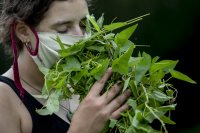
For students, finding an invasive insect in Maine is yet another ‘useful’ Bates experience
Finding an invasive and destructive insect in the woods of the Bates–Morse Mountain Conservation Area is no one’s idea of good news.
How the insect was found, however, does hit better notes.
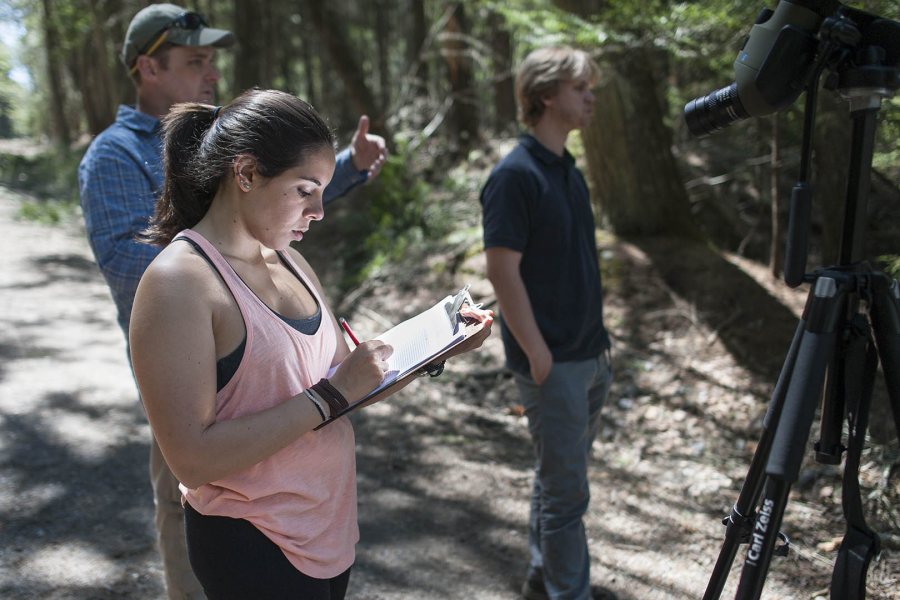
Emma Katz ’17 of Holmdel, N.J., records hemlock observations at Bates–Morse Mountain on May 14. (Josh Kuckens/Bates College)
The invasive insect is the hemlock woolly adelgid (uh-DELL’-jihd), and it was observed by Assistant Professor of Biology Brett Huggett and his Short Term students on May 14 as they did fieldwork at Bates–Morse Mountain, located along the coast in Phippsburg.
“We saw it within about four minutes of entering the area,” says Huggett.
“I strive…to create useful experiences.”
Huggett is leading “The North Woods” this Short Term, a course that reflects his teaching and research interests, “all related to studying how forest trees respond to long- and short-term stress.”
So far during the course, he and his students have tromped all over New England to look at forested habitats from sea level to mountains. “All the forest types we can possibly find,” he says. The only thing he wasn’t able to schedule was a trip to alpine environments. “I was a little worried about snow melt after a long winter!”
In addition to the fieldwork, the course has given his students myriad chances to work with alumni and other experts as well as state agencies and organizations, all of which fits with his idea of what it means to be a Bates teacher and scholar.
“I strive to make every effort, on behalf of my students, to create useful experiences,” he says. That approach fits nicely with key Bates initiatives, including Purposeful Work, and the college’s robust culture of community-engaged learning.
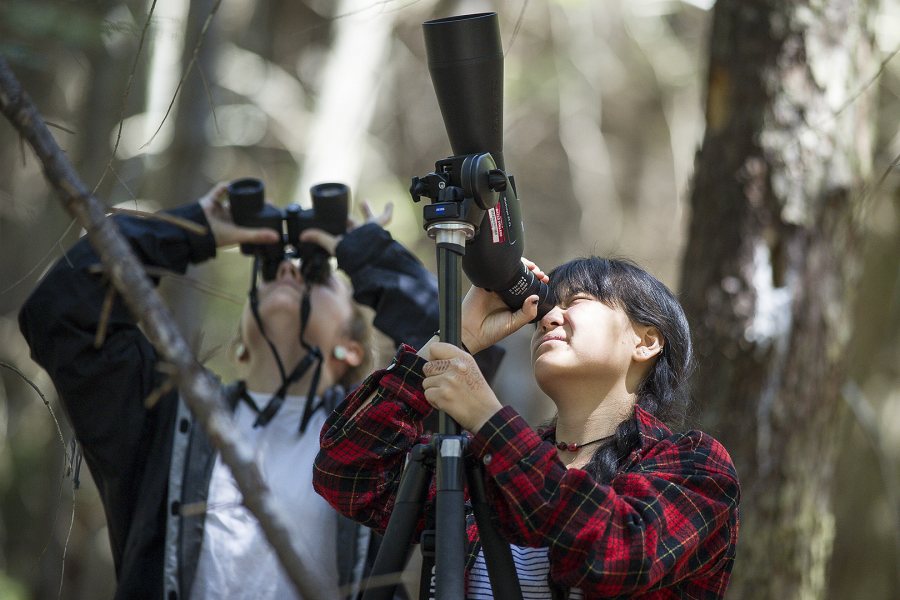
At right, Monata Song ’17 of Saratoga Springs, N.Y., observes hemlock trees at Bates–Morse Mountain with Alison Ricciardi ’17 of New Vernon, N.J. (Josh Kuckens/Bates College)
Accidentally brought to the U.S. from Japan in the 1950s, HWA has moved north ever since. It stalled along the Massachusetts–New Hampshire border for a while — cold winters limiting its spread north — but began creeping into coastal counties in the early 2000s.
“There are two hypotheses” about why it keeps moving, says Huggett. “One, it could be rising winter temps. Or, it could be that as it moves north, the HWA could be becoming more cold-hardy and able to survive.”
The insects are spread by wind. A few years ago, when Huggett was starting his career, in Massachusetts, he noticed that HWA was concentrated along commuter rail lines. “When the trains went by, they’d blow the adelgids down the rail line. They became like infected veins.”
By 2014, HWA in Maine had been observed further Down East than Bates–Morse Mountain, so it was really just a matter of time before it was seen at the conservation area.
The loss of hemlocks to HWA would affect coast ecosystems in a few ways, Huggett explains.
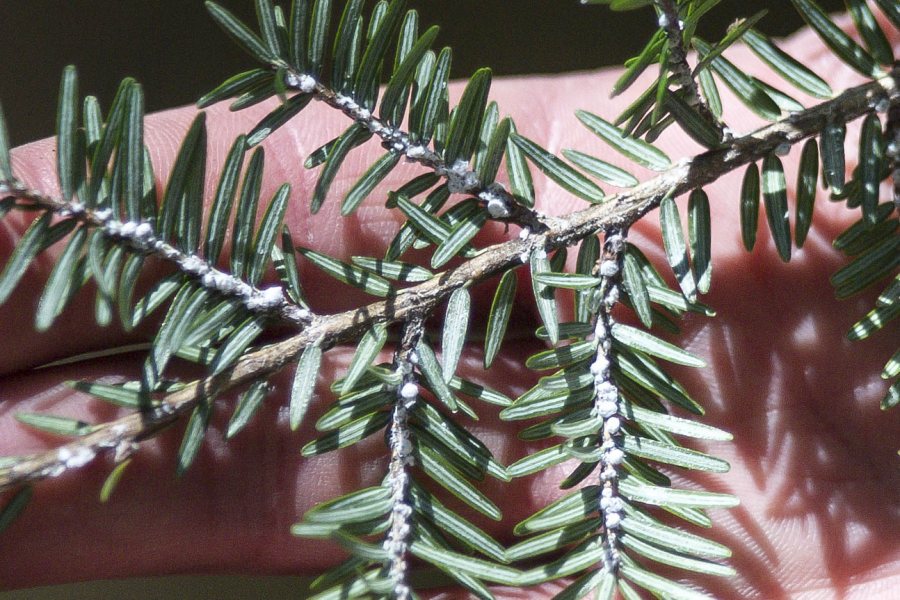
This hemlock branch shows the presence of woolly adelgid. Note the tell-tale white woolly masses on the undersides of the twigs. (Josh Kuckens/Bates College)
While hemlock trees are often interspersed with other conifers and hardwood trees, they’re sometimes found in entire groves. At Bates-Morse Mountain, their dense, broad canopies keep the soil below at moderate temperatures. “All kind of habitats depend on hemlock stands,” he says, including vernal pools and season-long habitats for salamanders.
“It would be sad to lose these hemlocks, in many ways.”
This is Huggett’s first year on the faculty, and his very first thesis student, Erica Gagnon ’15 of Weymouth, Mass., did her research on HWA and addressed the tree’s ecological importance. “The hemlock is a foundation species, aiding in the creation of stable conditions on which other species depend,” she writes, including more than 90 species of birds and 40 species of mammals.
“It would be sad to lose these hemlocks, in many ways,” says Huggett, who notes that there’s no highly effective way to stop HWA.
Bates-Morse Mountain is a remarkably intact and healthy ecological system, notably free of invasive plant species, says Bates-Morse Mountain director Laura Sewall. “But the HWA reveals its inevitable exposure and vulnerability.”
As Huggett planned his North Woods course over the winter, he and Sewall talked about her program needs, two of which were to update a 2002 self-guided nature walk and to look for HWA within the conservation area.
The pest feeds on the base of hemlock needles, “on the stored carbohydrate reserves,” Huggett says. “It depletes the reserves, leading to needle loss, which compromises the photosynthetic capacity of the tree.”
An infected tree can die within 10 years.
Huggett and his group have reported their HWA observations to the state through Vital Signs, an initiative of the Gulf of Maine Research Institute that empowers citizen-scientists to report and share critical environmental information with scientists and managers. (Here’s what the report looks like.)
“This is the community-engaged learning part of the course,” Huggett explains, nodding to the college’s tradition of helping faculty partner with local, state, and regional agencies on real-world issues, a tradition fueled today by the Harward Center.
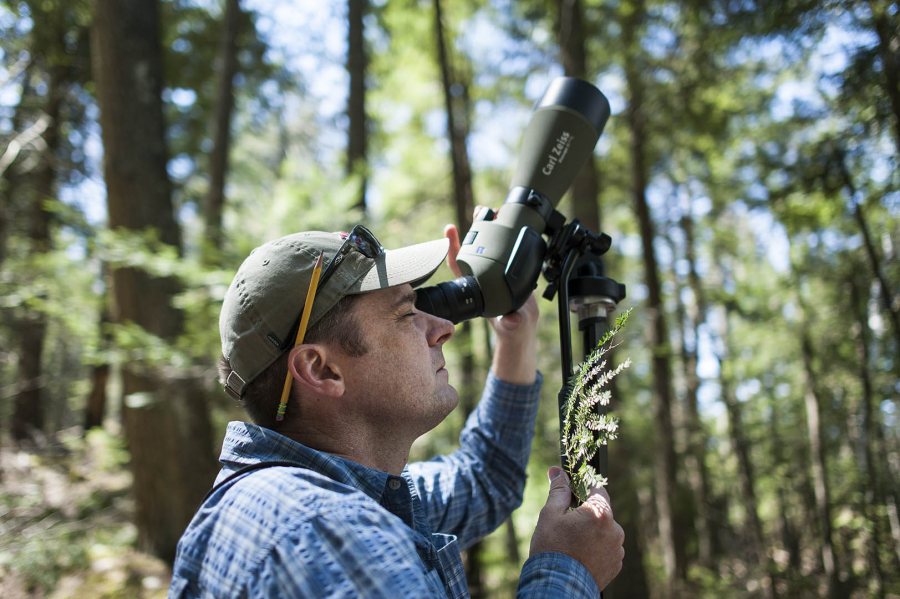
Holding a hemlock branch infested with woolly adeljid, Brett Huggett looks through a telescope at tree canopies at Bates–Morse Mountain on May 14. (Josh Kuckens/Bates College)
Vital Signs has been a key part of the Short Term fieldwork throughout Maine, says Huggett, as he and his students have created so-called Species ID cards to bolster the site’s database. Like baseball trading cards, the online Species IDs cards feature photos of plants or trees plus text that gives key facts and observations.
By working on the Species ID cards, Huggett’s students got a dose of Purposeful Work, the college priority that draws connections between what a student learns in class with post-Bates work and career ideas.
“Community-engaged work isn’t a one-way process.”
This concept was personified by Scott McAuliffe ’99, a member of the Vital Signs team at the Gulf of Maine Research Institute. From McAuliffe, the Bates students learned how a Bates bio major, armed with a master’s in marine resource management and training in multimedia production, now works to communicate and educate the public about research science in Maine.
After Bates students contribute their Species ID card to Vital Signs, and after the Vital Signs team curates and posts them, it’s time for various species experts, such as foresters and scientists like Huggett himself, to add value by checking facts.
“There are interactions between students and the experts,” he says. “Student learn how community-engaged work isn’t a one-way process.”
On another occasion, during fieldwork in Grafton Notch State Park, the students got more Purposeful Work insights by meeting Andrew Cutko and Justin Schlawin ’05, ecologists with the Maine Natural Areas Program.
“They introduced the students to a state forester, who gave us a tour of a timber-harvested site, explaining its importance, how timber harvesting can be done the right and wrong ways,” explains Huggett.
The group also hiked part of the Appalachian Trail with Cutko and Schlawin, who “talked about an incredible project they have going on: fieldwork to improve an aerial image analysis of vegetation types on the entire AT.”
The students got a hands-on taste of what it is like do fieldwork, “but also how a small amount of fieldwork ties into a big picture, like measuring vegetation habitats on the entire AT, which ties to an even larger project to monitor the trail in relation to global climate change.
“Now that’s really cool,” Huggett says.




